What’s one of the first things you check as soon as you wake up? By any chance is it your email?
If it is, you’re not alone. In fact, 58% of people check their emails first, before social media (14%), and search (20%).
While email may not be as novel as messenger bots and social media platforms, it remains to be a top tool in both B2B and B2C marketers’ arsenal.
Below we explain to you why this is the case. We’ll also provide you with easy-to-follow steps and free tools you can use so you can start your first email marketing campaign as soon as--or even while reading--this guide.
What Is Email Marketing?
Hubspot defines email marketing as “the practice of sending various types of content to a list of subscribers via email.” It's one of the channels used for a comprehensive digital marketing campaign.
Your purpose for sending emails may vary such as to:
• Promote your services or products to current and potential customers;
• Build brand awareness;
• Nurture customer loyalty;
• Educate clients, i.e., how-tos or guides on how they can maximize the use of your product;
• Upsell;
• Or strengthen your relationship with current clients.
The Benefits of Email Marketing
Email marketing is NOT dead. In fact, it remains almost as, if not more powerful than, other marketing channels. Below are some reasons why small and big businesses alike must take their email marketing campaigns seriously.
Extensive Reach
According to Statista, there were 3.8 billion email users worldwide in 2018. This number is expected to reach 4.4 billion by 2023. In contrast, there were around 2.65 billion social media users globally in 2018, and this is expected to increase to 3.1 billion by 2021.
In addition, email marketing lets you reach your subscribers whether they are on mobile or desktop. Based on GetResponse’s Email Marketing Benchmarks, while desktop opens account for 45.69% of email opens, mobile opens also account for a huge share of email opens, at 34.31%.
Higher Engagement Rates
Social media (Facebook, Instagram, and Twitter) engagement rates were around 0.58%. Meanwhile, consider these figures for email marketing:
• Your emails will reach around 85% of your target recipients. This immediately increases the chances that your readers will see your content, compared to social media where you have little control over whether followers will even see your posts.
• Emails have an open rate of 22.86% across industries.
• Emails have a click-through rate of 3.71%, or more than 6x the engagement rate of the social media platforms mentioned above.
Low Cost, High ROI
Email marketing software providers offer plans and affordable pricing that vary based on features and number of subscribers. If you are still starting out and building your contact list, find a provider that offers a basic plan that already includes features like marketing automation and landing pages.
Compared to its cost, email marketing has a very high return on investment (ROI). A 2018 Litmus study places the ROI at an average of $38 return per $1 spent, while other sources place potential returns up to $44 return per $1 allocated for email marketing activities.
Easier Tracking
In a 2018 study by HubSpot, among marketers’ top marketing challenges were proving marketing activities’ ROI (39%), and securing sufficient budget (27%). Another Hubspot study also shared that “marketers that calculate ROI are 1.6 times more likely to receive higher budgets.”
Email marketing helps address marketers’ dilemma as software providers allow you to track the results of your campaigns. By tracking your results, you have data to show higher-ups how much revenue your email campaigns have generated. At the same time, you can more easily identify ways to improve your email’s deliverability and engagement.
Greater Customization
Unlike other marketing channels, there are so many ways to customize and automate your campaigns. You can craft your own email templates and A/B test individual variables.
Equally importantly, you can segment your subscribers based on common traits, potential/current clients, materials they’ve downloaded, courses they’ve enrolled in, etc. This allows you to create customer journeys and automation workflows specific to that segment.
So instead of promoting the same product to all your subscribers, you can create exclusive offers to your current customers, then provide free shipping offers to those who are yet to make a purchase.
The Big HOW: Getting Started with Email Marketing
1. Plan, Plan, PLAN
You can, of course, jump straight to your first email marketing campaign even without a strategy in place. But if you wish to increase your chances of getting higher ROIs, you need to have even a basic email marketing strategy.
GetResponse defines email marketing strategy as the “big picture showing the long-term vision and future direction of your email marketing activities.”
Once you have identified the big picture, you can start putting the details--the email marketing campaigns and activities that will turn that big picture into reality.
So what must be included in your email marketing strategy? At the very least, you need to do the following:
• Set your business goals.
• Identify metrics and key performance indicators (KPIs).
• Identify your target audience.
• Determine your unique selling point.
• Ready your resources.
Set your business goals
Always begin with your desired end in sight. Determine what you want to achieve, and make sure these are measurable and precise. For example:
• Instead of simply hoping to have more subscribers, you can set a goal of increasing the number of people who opt in to your email newsletters by 15%.
• Instead of simply considering improving your open rates, why not set a goal of increasing open rates by 5%?
Identify metrics and key performance indicators (KPIs)
Once you name your objectives, you can determine what KPIs you need to track. This allows you to determine how close you are to reaching your goals and adjust if you are falling too far behind.
For the examples above, you need to keep an eye on:
• The number of email subscribers in your list.
• Your open rate, which is the percentage of subscribers who open your emails.
• Your click-through rate (CTR), which is the percentage of clicks on a link contained in your email over your total number of emails.
• Your conversion rate, or the number of subscribers who click on your call-to-action button and take action. Depending on your goal for a campaign, this may include subscribers who download a report, opt in to your emails, or those who purchase a product or service.
Identify your target audiences
Instapage defines target audiences as “hypothetical representations of groups of people you want to market to.” Your target audience includes of course, your target buyers but also other people such as influencers and company staff who may influence your target buyers’ decisions.
For instance, if you are selling a B2B service, your target buyers may be companies or business owners. But your target audience may also include decision-makers and key staff who may influence purchase decisions, and whose tasks may become much easier using your service.
Try to identify your target audiences’ wants and needs, so you can later continue customizing email marketing campaigns that meet their priorities or preferences.
Determine your unique selling point
In a sea of marketers and businesses, you need to stand out. One way of doing this is by highlighting your unique selling point, which are the reasons why potential clients must choose you over the competition.
When identifying your unique selling point, be sure to tie this in with your target audiences’ needs. How does your product/service meet those needs or priorities? Or take it a step further and identify how you fulfill these better than your competition.
Ready your resources
Resources include the tools (such as the email marketing platform) and human resources you need. At the start, you can have content specialist or copywriters. As your email marketing needs and budget expand, you can add email marketing specialists and graphic designers on your team.
2. Get permission
If you buy email addresses or send commercial emails to people whose business cards you have gathered from different events (and did not opt to receive emails from you) violates the CAN-SPAM Act.
To avoid getting penalized, obtain necessary permissions through opt-in forms. Be sure that individuals are explicitly informed that they will receive emails from you. Likewise, provide recipients with ways to opt out of emails, and honor these requests within 10 business days.
If you are serving EU-based clients, then be sure you understand and comply with the General Data Protection Regulation (GDPR). Do not use pre-ticked boxes and be sure to include unsubscribe options in all of your emails. Below is an example of an explicit opt-out information used by Litmus. Do check out Sendinblue’s tips for GDPR-compliant opt-ins as well.
3. Create Compelling Content
A buyer’s journey typically includes five stages: awareness, consideration, evaluation, purchase, and post-purchase.
In your email marketing campaign, you need to deliver emails that match where they are in their buyer’s journey.
Awareness
The awareness stage can include landing pages where people can subscribe to your email list. You can then follow this up with a welcome email campaign to nurture subscribers’ interest in your brand or product.
Here’s a snippet of Optinmonster’s Welcome email:

Consideration
At this stage, help your subscribers know more about your brand. Show them how your product can help solve their problems.
For example, here’s a snippet from Litmus’s email. It has a CTA that leads you to their infographic “Should you test that email? We made a handy decision tree to help you decide.”
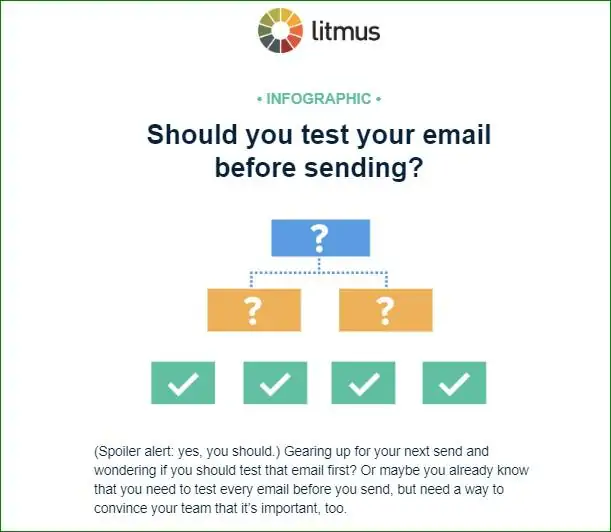
Note that by sending this material (and linking it to the full content), Litmus is educating their buyers why they must test emails. At the bottom of the content, they then mention that Litmus makes it easy for users to test their emails.

Evaluation
During this stage, create email marketing campaigns that will convince target audiences that you are the solution they’ve been looking for. You can use this as an opportunity to emphasize your unique selling points.
Purchase
By now, your subscribers already know about your unique offer and are more likely ready to buy. Create email campaigns with compelling offers that will help seal the deal.
Below are fragments of Grammarly’s email. They are helping subscribers better see the benefits of a premium over a free account (which a user may already be using). They even topped it off with a 50% discount available within a limited time period.
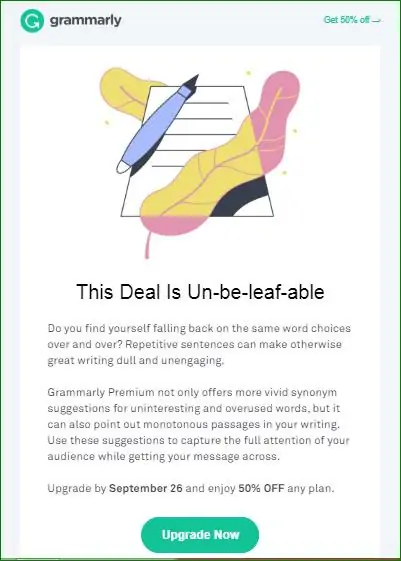

Post-Purchase
Even after clients buy or use your product, keep in touch with them and gather their feedback. This will help you gather more information about your customer’s experience, expectations, and needs. You can then use this to improve your product or email campaigns, or help buyers get the most out of your product.
Here’s a fragment from HP Life’s email.

What are the 4 types of email marketing emails?
There are primarily four types of email marketing campaigns you can send, depending on your goals. These are marketing offers, announcements, event invitations, and newsletters.
Marketing Offers
These email campaigns’ primary objective is to promote products and services and entice subscribers to click the buy or order button. You can do this by providing limited-time offers, giving them a sneak peek of the product, or simply providing them more information about your services.

Announcements
Use email announcements to broadcast new products or services and features. These can help keep your clients updated, and at the same time prompt potential buyers to consider purchasing as well.
Here’s a snippet from Helium 10’s email on a feature update.
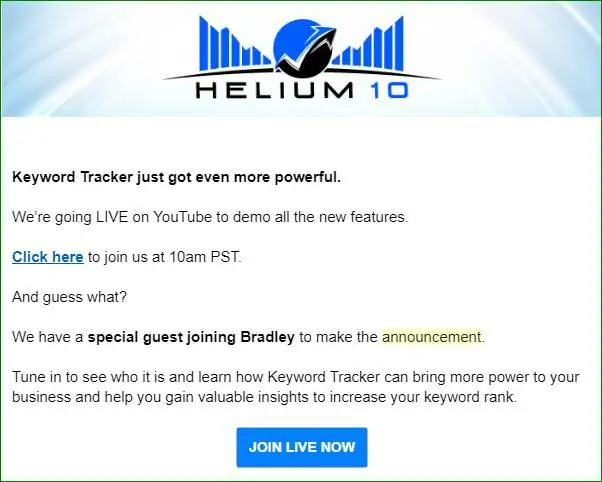
Here’s another example from Helium 10 that helps build awareness and anticipation for an upcoming announcement.

Event Invitations
Your event invitations aim to inform subscribers about upcoming happenings in your brand. These can be invitations to events to be held in a physical location or an online event.
Below is a fragment of an invite from the Digital Marketing Depot webinar “How to Stand Out in a Crowded Martech Landscape.”
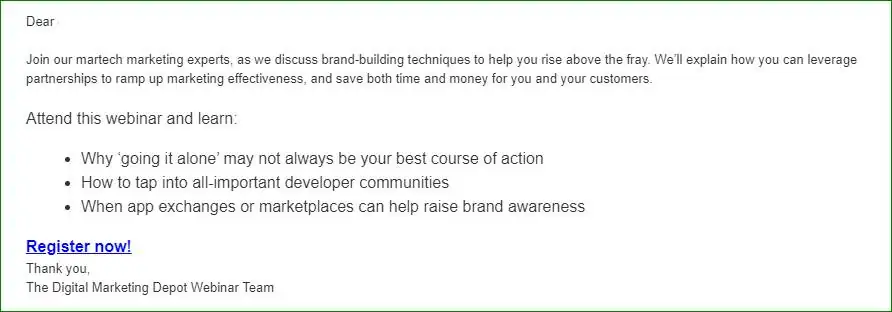
Newsletters
Last but not least are email newsletters. These are regular email campaigns which intend to nurture your relationship with your subscribers and keep you top-of-mind.
Email newsletters often deal with only one topic. To increase your open rates and CTRs, Campaign Monitor suggests the tips below. You can also follow these tips when creating other types of email campaigns.
• Use a “From” name that subscribers recognize. If they know it’s you and they remember signing up to your email list, then they are more likely to open your emails.
• Break it into easily digestible chunks. Because your readers will most likely give your newsletter a quick scroll, you need to design newsletters into short chunks.
• Use images. Using catchy visuals to help them process more information within a short time.
• Highlight customer benefits. When writing your headings and copy, remember to put yourself in the shoes of your subscribers. Highlight what benefits they get from opening or reading your newsletters.
• Make your CTA stand out. Your CTA needs to capture your reader’s attention. This lets them quickly determine what action to take even as they quickly browse your email.
Below are fragments of Goodreads’ September 2019 newsletter. Notice how they divided the section into parts (Big Books of Fall, Exclusive Interview, Movers & Shakers), used images and less text, and used a different background for the CTA buttons.
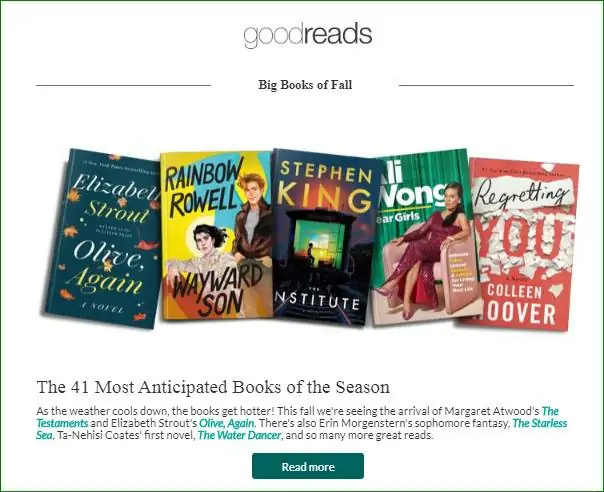
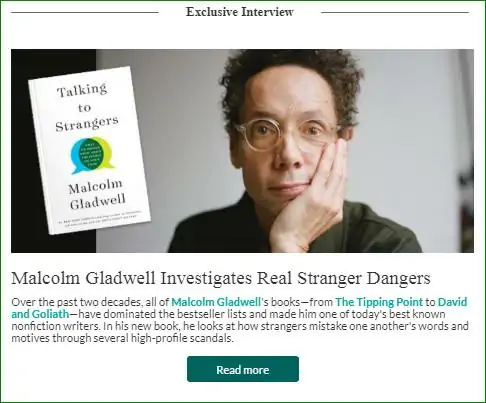
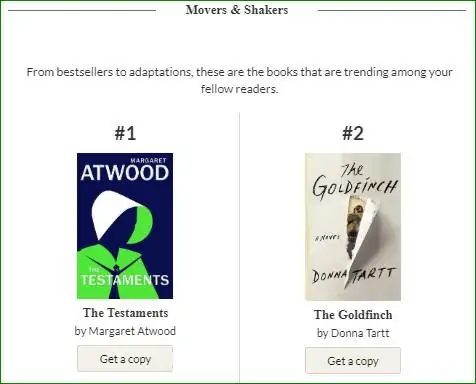
How do you create email marketing content?
Before you write your first email or campaign, you need to get clear on the following:
• How do you wish to present yourself or your brand: Do you want your writing to take on a formal or professional tone? Or do you wish to be more informal and your writing more conversational?
• Your goal for the email: Identify what you wish to achieve with this campaign or email.
• The messages or benefits you wish to focus on: Always keep your readers in mind. Instead of simply highlighting your product features, think about how these features solve their concerns or appeal to their interests.
There is a wide range of content you can use to encourage your potential audience to subscribe and stay engaged through email. Your content can include:
• Inspiring emails
• Videos
• How-tos or tutorials
• Infographics
• Ebooks
• Reports
Whichever content you choose, keep in mind that it needs to be valuable to your target audience. Take this example from Trello about keyboard shortcuts for their users.

Also, make sure your writing is succinct, simple, and straightforward. If you have opted for an informal tone for your emails, make your copy as conversational as possible.
Once you have your content ready, write a good, catchy subject line. The quality of your subject line will affect your email open rates, so make sure it entices your subscribers to click on your email. You can use a question, a reaction, or an offer. You can even include emojis to help your subject line stand out.

How Do I Create an Email Marketing List?
To get your target audience to subscribe, you either display a “Subscribe” option in your website, install popups, or provide a compelling offer.
For B2B marketers, the offer can be a free report that you know your target audience can use. For B2C businesses, it can be a free webinar or lecture series.
Another way is to provide social media sharing options in your email. Each time your reader shares a part of your email on social media, more people may discover you. GetResponse found that emails with social sharing options actually have higher average CTRs--6.2% as compared to other emails with 2.4%.
Email Marketing Best Practices
Achieving high ROIs with email is not an accident, but a product of carefully crafted and planned content. Below are some of the best practices you can use to improve your email marketing results.
Personalize Your Emails
When your readers open your email, make them feel like the content is tailored for them, or feel like you are having a talk with them. One way to achieve this is by personalizing your emails. You can ask for your subscriber’s first name when they opt in. Then include their first name in the email’s subject line, the salutation, or within the body of the email.
Segment Your List
Neil Patel defines segmentation as “the practice of splitting up your email list into more targeted groups.”
There are several ways to segment subscribers. For example, you can have a segment for:
• People who availed a free product
• People who signed up for your course
• People who joined your webinar
• Current customers
• Potential clients
• Newsletter subscribers
Once you have segmented your subscribers, you can select which type of content goes to each. For example, you can send upsell campaigns to current customers, while potential buyers receive email campaigns on discounts and product offers.
Build Your Reputation
Your readers will be interacting with your brand through your emails. So apart from ensuring these have been proofread, consider the following tips below.
Utilize a humanized tone
To keep your readers engaged, they must feel like they are talking with a human being, not a machine. So incorporate emotions into your emails. As much as possible, write in the first and second person. Consider this example.

Tell Stories
Whenever possible, incorporate a story in your emails as these are easier to remember. In addition, stories allow you to connect with your subscribers who may have had the same concern or experience.
You don’t need to tell a full-length story. It can be as simple as a question you’ve had, a setback you had to overcome, or a lesson you learned from your own career.
Consider this email from Marie Forleo and how fellow writers (or would-be published authors) can quickly empathize or get curious over the question: “Why didn’t anyone tell me this before I began crafting my manuscript?” While the email also promotes her book, the message focuses on the benefits--book writing tips--her readers can get.
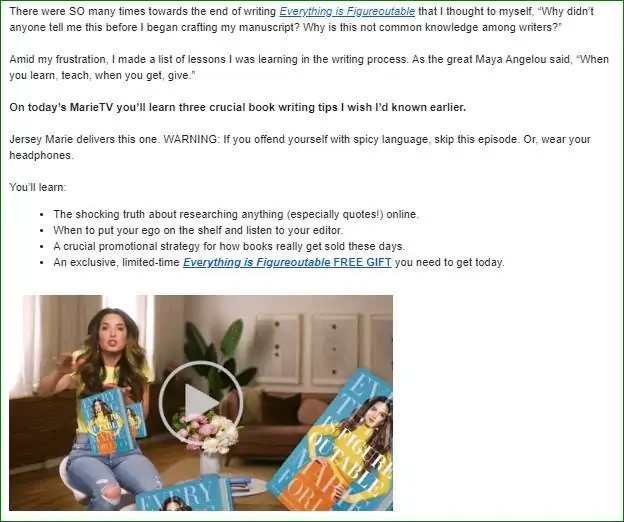
Say “Welcome” and “Thanks”
As mentioned above, email marketing is about forming and nurturing a relationship with subscribers, and both “Welcome” and “Thank You” emails allow you to do just that.
Welcome emails also offer a sales opportunity as these have, on average, four times higher open rates and five times higher click-through rates than your other emails.
Even thank-you emails provide opportunities to nurture an active subscriber’s engagement and offer them related content or services. Consider this thank-you email from Hubspot that puts the content right into the user’s inbox and included conversion opportunity.

Relevance
One of the top reasons people unsubscribe to email lists is the content is no longer relevant. As such, you need to ensure that your content speaks to the needs and priorities of your subscribers. In other words, your email content must remain useful or valuable to them.
Design
One way to make your emails more appealing is to include images. Aside from helping convey your message, images can also break up your email so it looks less text-heavy. It also makes your emails more interesting and eye-catching.
When choosing an image, consider prioritizing those with human faces. Eye-tracking research indicates that familiar human faces and logos tend to get the most attention.
Remember to have user-friendly and mobile-optimized designs for your emails as well as your opt-in forms and landing pages. As more and more consumers are using mobile phones to check their emails, you need to be sure your content and campaigns look good across different screen sizes.
Great CTAs
Your CTAs need to be short but catchy. Make sure it stands out and does not get lost amidst your email’s content. To do this, you can use a larger font size or a different color for your CTA button, such as this fragment from Harvard Medical School’s email “4 ways to get better sleep.”
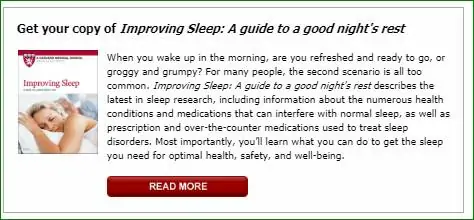
A/B Test
You can A/B test different components of your email, such as:
• Headlines
• Content layout/design
• Images
• Subject lines
• CTAs
• Offers
A/B testing allows you to determine what works and what doesn’t work, so you can tweak these and improve your KPIs. For example, if you have a low open rate, then you can start testing your subject lines. If you have low CTRs, test different CTAs or offers.
If your email software provider offers A/B testing, then you can use their tools to test different versions of your email. Otherwise, you need to manually test each version by sending it to separate lists and seeing which one generates your desired result.
When you are starting to A/B test, remember to do the following:
• As much as possible, test only one component or variable.
• Send each version simultaneously to two separate lists.
• Test it with a large sample to increase your result’s precision.
Always track results
Whether or not you are A/B testing, you need to track your results and compare these with the goals you’ve set. So look at your data and check:
• Which types of content are generating the highest email opt-ins?
• How many new subscribers have you had during a campaign?
• How many have unsubscribed? Are readers unsubscribing after a particular marketing email?
• Which offers are getting low click-through rates?
• Which emails are getting high click-to-open rates? (CTORs are computed by dividing the number of subscribers who click your CTA after opening your email.)
• Which types of content are getting the most engagement?
• How much is your email ROI? (You can compute this by taking your revenue via email and dividing it by your email marketing expenses.)
Use these results to inform your next campaigns, or to revise your emails and begin another batch of A/B tests.
Recommended Email Marketing Tools
There are a number of email marketing tools with from freemium to paid plans. Let’s look into three: MailChimp, Drip, and GetResponse.
MailChimp
MailChimp is an all-in-one marketing platform. Aside from having a free forever plan, MailChimp is also easy to use, making it a good choice for bloggers and start-ups who are new to email marketing.
With a free plan, you can already use their basic templates, include up to 7 marketing channels (such as email, landing pages, pop-up forms), and use a marketing CRM for up to 2,000 contacts. The free plan already includes segmentation, but if you want to A/B test, you need to get one of their paid plans.

Drip
For eCommerce business owners or anyone selling several products and services, Drip is a perfect option. It is easy to use for beginners. Plus, it allows users to create advanced marketing sequences and create deeper segmentations and personalizations.
Drip offers a two-week free trial, after which you can avail of their basic plan ($49/month), pro ($122/month), or a customized enterprise plan.

GetResponse
For small and medium-sized businesses, GetResponse can help you easily create landing pages, emails, and marketing funnels. They even provide webinar marketing solutions, and they also allow you to segment your list and A/B test your emails.
GetResponse offers a 30-day free trial for their plans, which start with a Basic plan $15/month for a list size of 1,000. If you don’t wish to upgrade your plan but would like to increase your list size, simply click on the dropdown menu beside “List Size” per plan. The Pricing page will automatically show you how much the plan will cost. For example, a Basic Plan with a list size of 5,000 will cost $45/month.
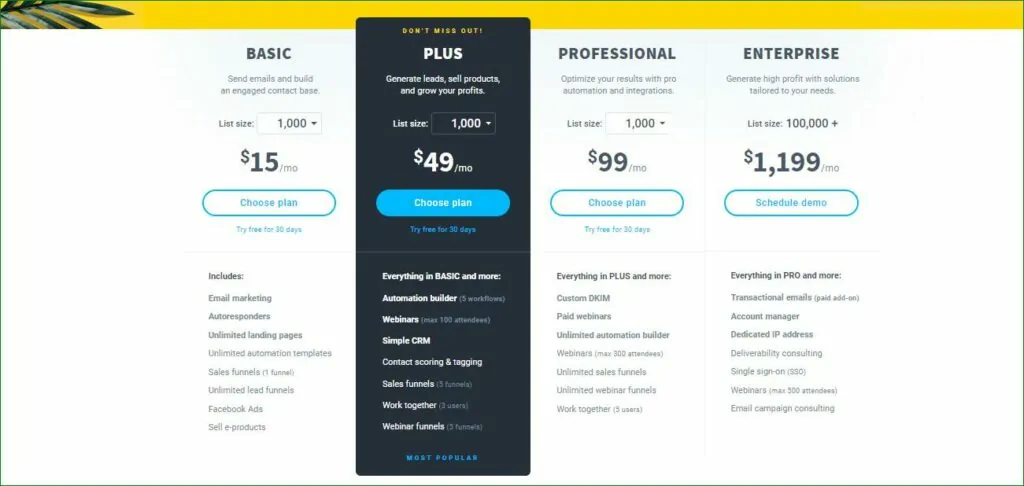
THE BIG QUESTION: How can I do email marketing for free?
When starting out with email marketing or even opening your first business, you may be hesitant to spend. Or perhaps you have a limited budget. If this is the case, find email marketing tools that will allow you to start growing your email list either by (1) starting with a forever-free plan, or (2) getting free trial before purchasing a package.
But there are limitations. Free plans come with limited features, and may not allow you to do A/B testing and deeper segmentation. Also, they are only good so long as you don’t exceed the list size. Forever-free offers sometimes have limited customer support as well.
If you’re okay with these restrictions (at least for now), then go ahead and find free email marketing tools that will help you flourish in your niche. The point is to start NOW.
Conclusion
Given all the information and possibilities of email marketing, beginners may feel overwhelmed, even intimidated, to start their own campaigns.
But don’t let this delay you from building your email list. You can have this guide open as a reference while you create an email marketing strategy and your first campaign.
Keep in mind that email marketing provides one of the highest ROIs. If you’re not leveraging it, then you’re leaving a lot of money on the table.
